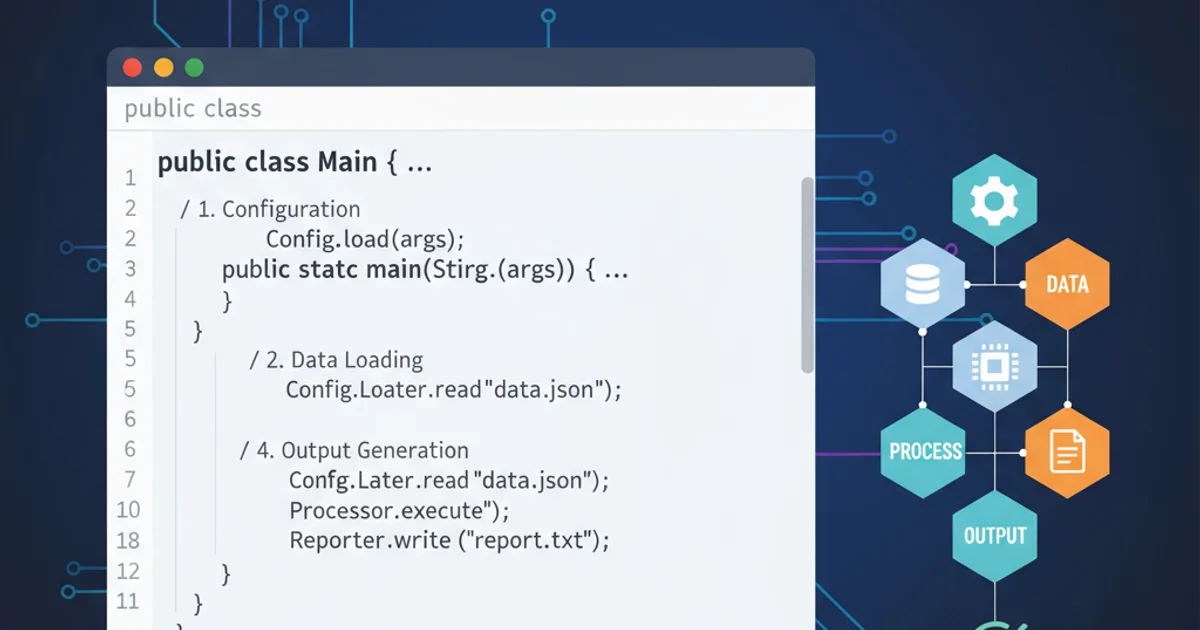Best coding (layout) practice for the "main() class" file?
Categories:
Best Practices for the main() Class File Layout in Java

Explore effective coding practices for structuring your main() class file in Java, focusing on readability, maintainability, and common conventions for program entry points.
The main() method serves as the entry point for Java applications, making its containing class a critical component of any project. While Java offers flexibility in how you structure your code, adopting best practices for the main() class file can significantly improve readability, maintainability, and overall project quality. This article delves into recommended layouts and considerations for your primary application entry point.
Understanding the Role of the main() Class
The class containing the main() method is often the first file a new developer encounters when exploring a project. Its primary role is to bootstrap the application, initialize core components, and orchestrate the initial flow. Depending on the application's complexity, the main() method itself might be concise, delegating work to other classes, or it might contain more direct logic for simpler utilities. The key is to ensure its purpose is clear and its structure supports easy understanding and modification.
flowchart TD
A[Application Start] --> B{"main() method called"}
B --> C{Initialize Configuration}
C --> D{Create Core Objects}
D --> E{Start Application Logic}
E --> F[Application Running]
F --> G[Application End]Typical application startup flow orchestrated by the main() method.
Layout and Structure Recommendations
A well-structured main() class file adheres to several principles, including clear naming, logical grouping of elements, and minimizing unnecessary complexity. Here are some key recommendations:
1. Keep main() Concise
The main() method itself should ideally be lean, primarily responsible for calling other methods or instantiating classes that handle the actual application logic. This promotes separation of concerns and testability.
2. Separate Configuration
If your application requires significant setup (e.g., loading properties, configuring logging, setting up dependency injection), consider moving this logic into dedicated utility methods or configuration classes. The main() method can then simply call these setup routines.
3. Handle Exceptions Gracefully
Wrap the core logic within main() in a try-catch block to gracefully handle unexpected exceptions that might occur during application startup or execution. Provide informative error messages.
4. Use Meaningful Class Names
The class containing main() should have a name that clearly reflects its role as the application's entry point, such as Application, Main, or AppRunner.
5. Avoid Business Logic
Resist the temptation to embed complex business logic directly within the main() method. This makes the code harder to test, reuse, and maintain. Delegate to other classes and methods.
Example: A Well-Structured main() Class
Consider a simple Java application that processes some data. Here's how its main() class might be structured, demonstrating the principles discussed:
package com.example.myapp;
import com.example.myapp.config.AppConfig;
import com.example.myapp.service.DataProcessor;
import com.example.myapp.util.LoggerUtil;
public class Application {
public static void main(String[] args) {
LoggerUtil.initializeLogger();
try {
// 1. Load application configuration
AppConfig config = AppConfig.loadConfig("app.properties");
LoggerUtil.logInfo("Application configuration loaded.");
// 2. Initialize core services
DataProcessor processor = new DataProcessor(config);
LoggerUtil.logInfo("Data processor initialized.");
// 3. Execute main application logic
processor.processData();
LoggerUtil.logInfo("Data processing completed successfully.");
} catch (Exception e) {
LoggerUtil.logError("Application encountered an error: " + e.getMessage(), e);
System.err.println("Application failed to start or run: " + e.getMessage());
System.exit(1); // Indicate abnormal termination
}
}
}
A main() class demonstrating clear separation of concerns and error handling.
AppConfig, DataProcessor, and LoggerUtil to illustrate the delegation of responsibilities. In a real application, these would be fully implemented classes.